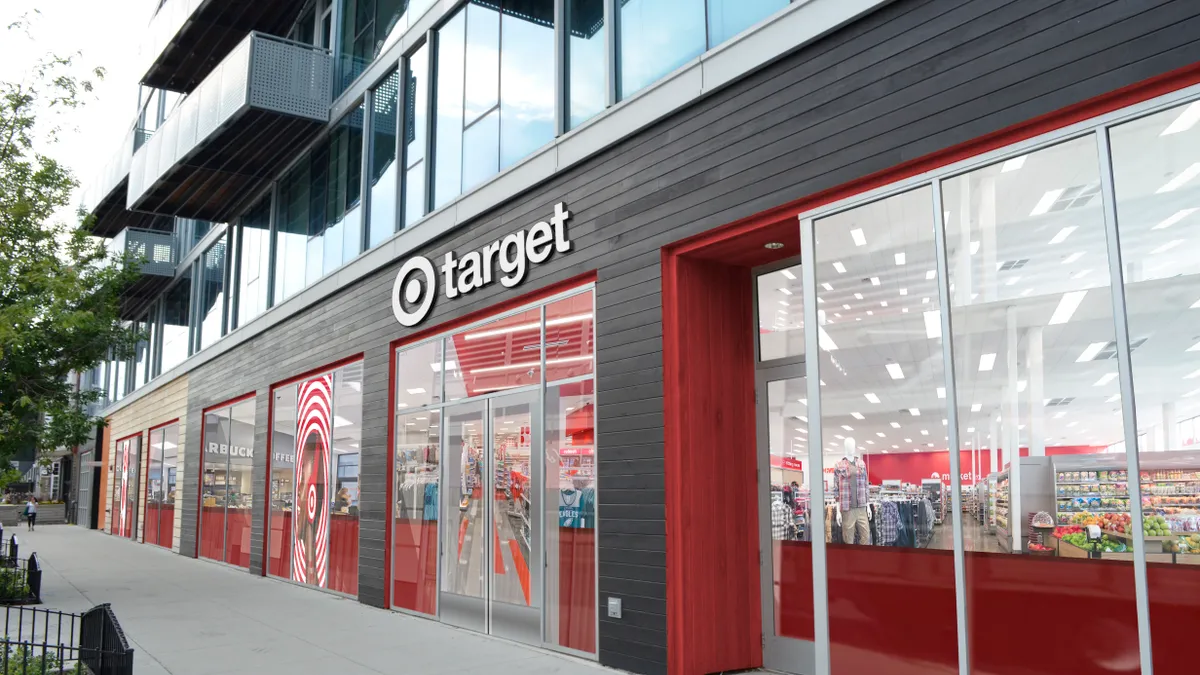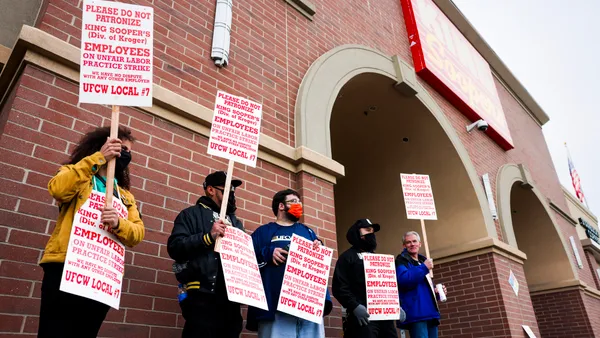Dive Brief:
-
Target on Tuesday reported that full year comp sales had their strongest performance since 2005, growing 5%. Store comps in the period rose 3.2%, while digital comps were up 36%, getting a boost from a 4.5% lift in traffic and beating expectations, according to Cowen.
-
The retailer reported its sixth straight quarter of comparable sales growth in grocery and gained market share in "essential" food categories, CEO Brian Cornell said in an earnings call Tuesday. He also noted that the company's decision to bring merchandising and operations together under one team, now led by Stephanie Lundquist, will pay dividends. "Having one dedicated leader who thinks about food and beverage every single day and is connecting the needs and supply chain to merchandising to store operations, I think it's going to yield significant benefits in the year to come," Cornell said.
-
For the fourth quarter, Target's overall sales were flat at $22.7 billion, while overall comp sales grew 5.3% (store comps grew 2.9% and digital comps grew 31%). Net earnings were down 26.5% to $799 million from $1.1 billion in the year-ago period
Dive Insight:
Target has quietly been hard at work revitalizing its grocery department. The chain best known for its cheap-chic apparel and tasteful home goods has also been optimizing its supply chain, retooling its merchandising strategy and updating in-store operations in food and beverage in an effort to drive traffic and boost baskets with cold beer, fresh produce and other offerings.
Those efforts are paying off, with the chain notching its sixth straight quarter of comparable sales growth in grocery. And Cornell hopes that growth will accelerate with Target's recent decision to bring its grocery merchandising and operations together under one leader — a move that recognizes the unique needs and challenges food and beverage presents to the primarily nonfood retailer.
"As we looked at that business, we recognize it's very different from many other parts of our portfolio," Cornell said during Tuesday's earnings call. "The products we source, the perishability of it, the cold chain environment, how we manage product from a store level. So, we made the decision to bring all of those elements together under one leader."
As industry analysts recently told Grocery Dive, however, Target should be doing an even better job. Indeed, grocery's strategic role at the company remains unclear.
"It’s hard to know what they’re trying to do [in grocery] beyond driving traffic," said Tory Gundelach, an analyst with Kantar Consulting.
At Walmart, grocery — and particularly fresh grocery — is used to drive online sales and acquire new customers. Costco has invested heavily in organic produce, while BJ's Wholesale Club promotes its perishable selection to drive store traffic and rope in new members. In addition to beefing up its operations and assortment, Target's next step may be to step up promotions and better define grocery's role within the company and to its customers.
Taking a broader look, Target continues to hit new milestones thanks to a two-year-old business plan that's now gaining traction. Within its end-of-year results, Target noted the $7 billion investment in 2017 toward three core areas to drive growth: speeding up its supply chain, building new private label brands and revamping stores to serve as hubs to fill e-commerce orders.
"Target's strategic initiatives, announced two years ago, are clearly bearing fruit, with its online push continuing to generate impressive gains," Charlie O'Shea, Moody's Lead Target Analyst, said in comments emailed to Retail dive. "Leveraging of stores to support these online sales remains compelling, with Target indicating that three-quarters of its online sales benefited from its stores."
That's also in part because stores are fresher. Last year, Target said it remodeled more than 300, and it plans to have over 1,000 remodeled by the end of 2020. Rolling out new small format stores in urban, suburban and college campus areas has also been a big part of that strategy. Last year, the company's fleet of such stores reached 87.
In its battles with Amazon and Walmart, Target is working to differentiate its stores. Like Walmart, Target is redesigning its stores to serve customers as convenience hubs, where shoppers can get in and out with what they need, either shopping themselves or picking up digital orders from the comfort of their cars. But Target has also remodeled many of its stores is to help drive inspiration, which plays into its "Tarzhay" ethos.
Target is well-positioned for another strong year, though in remains to be seen what effect some new initiatives will have. Last month, the retailer launched an invite-only third-party seller program called "Target +" to court specific brands to sell on its website. A carefully curated marketplace could open up the company to more growth if it can offer the right digital assortment for customers.













